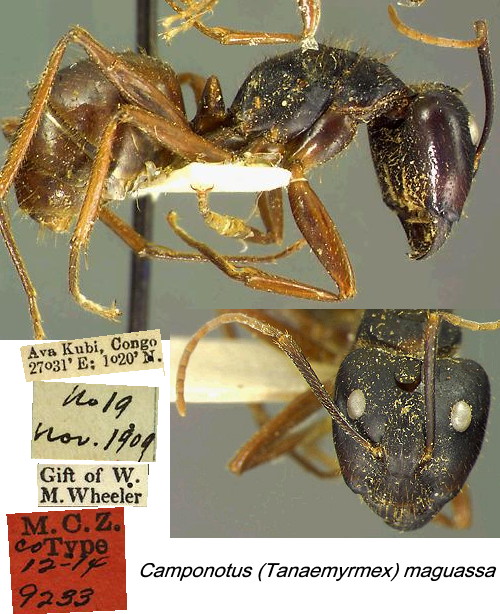 Description by Wheeler (1922) - Description by Wheeler (1922) -
MAJOR WORKER - TL 9 to 10 mm, Head rather small, subrectangular, as
long (1.3 mm. without the mandibles) as broad, a little narrower in
front than behind, with straight posterior and very feebly convex
lateral borders. Eyes rather large and convex, situated about their
length from the posterior border when the head is seen from the front.
Mandibles moderately convex, coarsely 6-toothed. Clypeus sharply
carinate behind, rather deeply emarginate on each side of the median
lobe, which is short, with straight border, distinctly dentate at the
corners. Frontal area subtriangular, indistinct behind; frontal groove
pronounced; frontal carinae approximated anteriorly. Antennae slender,
the scapes straight, terete, not enlarged at the tip?, reaching about
two-fifths their length beyond the posterior border of the head.
Pronotum flattened above, its sides distinctly marginate anteriorly;
mesonotum evenly arched in profile; metanotum indistinct; propodeum
with subequal base and declivity, both surfaces straight and sloping,
meeting at a rounded obtuse angle. Petiole rather high, oval when seen
from behind, in profile with flattened anterior and posterior surfaces,
its superior border rather sharp and entire. Gaster and legs as usual,
hind tibiae nearly cylindrical, only very slightly compressed, without
a row of bristles along their flexor surfaces.
Body subopaque, the petiole, gaster and legs more shining. Mandibles
coarsely and sparsely punctate, their tips striated, their bases
sharply shagreened. Head very densely, evenly and finely punctate, so
that it appears granular; the clypeus, cheeks, front, and vertex also
with large, scattered, irregular, piligerous punctures. Sculpture of
the thorax like that of the head but finer (especially on the pleura);
the dorsal surface with coarse, sparse, piligerous punctures. Gaster
finely, sharply and transversely shagreened, with coarse, sparse,
transverse piligerous punctures. These have minutely papillate anterior
borders so that the coarse hairs seem to rise from small projections.
Legs finely shagreened or coriaceous.
Hairs fulvous red, coarse, erect, rather abundant, long on the dorsal
surface of the head, thorax, and gaster, somewhat shorter on the gula
and petiolar border, still shorter but suberect on the cheeks, scapes
and legs. Pleurae, anterior and posterior surfaces of petiole hairless.
Pubescence rather coarse, very sparse, visible on the cheeks and
gaster. Brownish black; funiculi, tips of scapes, legs, including the
coxae, petiole, and gaster rich castaneous, the legs and funiculi
slightly paler.
The photomontage is a cotype major of from Zaïre
on the MCZ, Harvard University, website at - MCZ link.
|